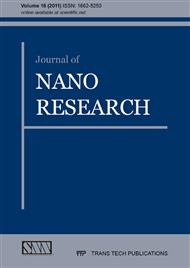p.29
p.37
p.43
p.49
p.55
p.63
p.69
p.77
p.83
Chitosan Capped Colloidal Gold Nanoparticles for Sensing Zinc Ions in Water
Abstract:
In this work, we report sensing of Zn2+ ions using chitosan capped colloidal gold nanoparticles in aqueous media. The chitosan capping not just acted as an electro-static stabilizer to the colloidal gold nanoparticles, but also could bind to Zn2+ ions if present in the solution. However, the Zn2+ ions chelation to the chitosan capping decreased the stability of the colloidal gold hence shifted the surface plasmon peak to higher wavelengths. The extent of this red shift was found to be dependent on the concentration of the Zn2+ ions and therefore the presence of Zn2+ ions could be determined both qualitatively and quantitatively by analyzing the optical spectra of the chitosan capped gold nanoparticles. The sensing capability was also affected by the size of the nanoparticles, which could be tuned by adjusting the molar ratio of the reducing agent and the gold salt to the desired levels. Optical characteristics showed satisfactory results in estimating the amount of Zn2+ ions in water. This is thus a promising method for on the spot assessment of heavy metal ion concentrations in water.
Info:
Periodical:
Pages:
55-61
Citation:
Online since:
January 2012
Authors:
Keywords:
Price:
Сopyright:
© 2011 Trans Tech Publications Ltd. All Rights Reserved
Share:
Citation:


